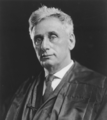Brandeis, Louis D.
Louis D. Brandeis was born on November 13, 1856, in Louisville, Kentucky. He studied at Harvard Law School and later began a law practice in Cambridge, Massachusetts, with Samuel Warren. He became a proponent of labor unions and did much pro bono work for various public causes. He married Alice Goldmark in 1891, and they had two daughters.
Brandeis became famous in legal circles with the so-called Brandeis brief. It occurred in 1908 when he argued before the Supreme Court in Muller v. Oregon (1908) in behalf of Oregon’s maximum hours law for women. Since there were not many precedent cases, and the few that there were generally went against those type of laws, Brandeis devoted only two pages in his brief to legal precedent, but devoted over 100 pages of data showing the bad effects on women of working too many hours. When the Court unanimously upheld the law, it paid tribute to Brandeis’s arguments and, even today, briefs that cite extensive social science data are called “Brandeis briefs.”
Brandeis helped President Woodrow Wilson formulate his antitrust program. In 1914, Brandeis was the leader of the American Zionist movement. In 1916, an opening arose on the Supreme Court, and Wilson nominated Brandeis, who was confirmed by a vote of forty-seven to twenty-two, becoming the first person of the Jewish faith to serve on the Court. During his years on the Court, Brandeis was a firm believer in the First Amendment rights, but a majority of the Court was more conservative than he was in cases involving freedom of speech, and he often dissented in those cases along with Justice Oliver Wendell Holmes Jr. The issue in contention was Holmes’s clear and present danger doctrine, with Brandeis and Holmes often finding that the defendants did not create such a danger.
Brandeis also wrote an impassioned dissent in Olmstead v. United States (1928). The majority upheld wiretapping but Brandeis dissented, arguing that wiretapping and other forms of surveillance constituted an unreasonable search and seizure in violation of the Fourth Amendment. It was important, Brandeis maintained, for the Fourth Amendment’s protection of privacy to keep pace with modern technology or else it would not mean much in the future.
Brandeis, while a supporter of Franklin Roosevelt’s New Deal, opposed the president’s court-packing plan. He was often a defender of federalism. In Erie Railroad v. Tompkins (1938), he held that federal courts could not use federal common law to decide a case; it must use the law of the state involved in the case, either statutory or common. And in New State Ice Company v. Liebmann (1932), he referred to the states as the “laboratories of democracy.”
Brandeis retired from the Court in 1939 and died of a heart attack on October 5, 1941. Due largely to his zeal for First Amendment rights and the right of privacy, he is rightly considered one of the greatest justices to ever serve on the Court.
| BIBLIOGRAPHY:
Alpheus T. Mason, Brandeis: A Free Man’s Life (New York: Viking Press, 1946); Philippa Strum, “Louis D. Brandeis,” in Supreme Court Justices: Illustrated Biographies, 1789–1993, ed. Clare Cushman (Washington, DC: Congressional Quarterly Inc., 1993); and Philippa Strum, Louis D. Brandeis: Justice for the People (New York: Shocken Books, 1984). |
Robert W. Langran
SEE ALSO: Erie Railroad Co. v. Tompkins; New State Ice Company v. Liebmann
